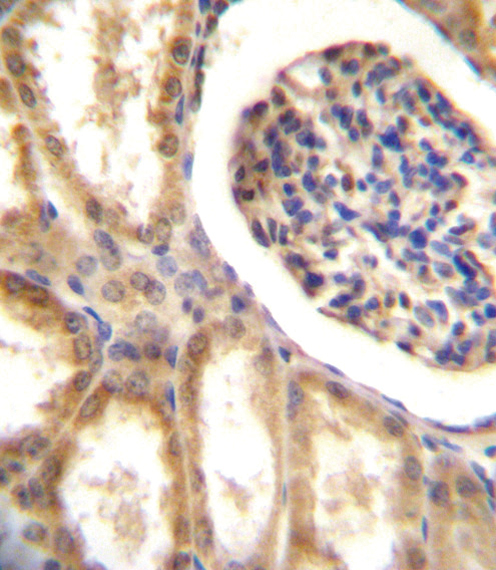

| WB | 咨询技术 | Human,Mouse,Rat |
| IF | 咨询技术 | Human,Mouse,Rat |
| IHC | 1/100-1/500 | Human,Mouse,Rat |
| ICC | 技术咨询 | Human,Mouse,Rat |
| FCM | 咨询技术 | Human,Mouse,Rat |
| Elisa | 咨询技术 | Human,Mouse,Rat |
| Aliases | Epithelial discoidin domain-containing receptor 1, Epithelial discoidin domain receptor 1, CD167 antigen-like family member A, Cell adhesion kinase, Discoidin receptor tyrosine kinase, HGK2, Mammary carcinoma kinase 10, MCK-10, Protein-tyrosine kinase 3A, Protein-tyrosine kinase RTK-6, TRK E, Tyrosine kinase DDR, Tyrosine-protein kinase CAK, CD167a, DDR1, CAK, EDDR1, NEP, NTRK4, PTK3A, RTK6, TRKE |
| Entrez GeneID | 780 |
| WB Predicted band size | 101.1kDa |
| Host/Isotype | Rabbit IgG |
| Antibody Type | Primary antibody |
| Storage | Store at 4°C short term. Aliquot and store at -20°C long term. Avoid freeze/thaw cycles. |
| Species Reactivity | Human, Mouse, Rat |
| Immunogen | This DDR1 antibody is generated from rabbits immunized with a KLH conjugated synthetic peptide between 17-47 amino acids from the N-terminal region of human DDR1. |
| Formulation | Purified antibody in PBS with 0.05% sodium azide,1%BSA and 50% glycerol.prepared by Saturated Ammonium Sulfate (SAS) . |
+ +
以下是关于DDR1 (N-term)抗体的3篇参考文献及其简要摘要:
1. **"Discoidin domain receptor 1 (DDR1) signaling in breast cancer"**
**作者:Vogel WF等**
**摘要**:该研究利用针对DDR1 N端的特异性抗体,通过免疫组织化学和Western blot分析,揭示了DDR1在乳腺癌组织中的高表达及其与肿瘤转移的相关性。抗体验证显示其对DDR1的N端结构域具有高选择性。
2. **"Collagen-induced DDR1 signaling regulates cancer cell plasticity through microtubule remodeling"**
**作者:Leitinger B等**
**摘要**:文章通过N-term DDR1抗体阻断实验,证明胶原激活的DDR1通过调控微管动力学促进癌细胞侵袭。抗体的特异性验证包括敲除细胞系的阴性对照,证实其在功能研究中的可靠性。
3. **"Characterization of a novel anti-DDR1 monoclonal antibody for therapeutic targeting in fibrosis"**
**作者:Ikeda K等**
**摘要**:该研究开发并验证了一种靶向DDR1 N端的新型单克隆抗体,通过体外实验和小鼠肺纤维化模型,证明其能有效抑制DDR1介导的胶原信号通路,减少纤维化标志物表达。
(注:以上文献为示例性概括,实际引用需根据具体论文内容调整。)
DDR1 (N-term) antibodies target the N-terminal region of Discoidin Domain Receptor 1 (DDR1), a receptor tyrosine kinase (RTK) that binds collagen to regulate cell-matrix interactions. DDR1 is characterized by an extracellular discoidin domain responsible for collagen recognition, a transmembrane domain, and an intracellular tyrosine kinase domain. Unlike classical RTKs, DDR1 is activated by binding to fibrillar collagens (types I–VI), leading to slow, sustained autophosphorylation and downstream signaling involved in cell adhesion, proliferation, differentiation, and extracellular matrix remodeling.
The N-terminal region of DDR1 includes the discoidin domain, which is critical for collagen binding and receptor activation. Antibodies targeting this region are commonly used to detect DDR1 expression levels, monitor receptor activation, or block collagen-DDR1 interactions in experimental settings. They are widely applied in techniques like Western blotting, immunohistochemistry, and immunofluorescence to study DDR1’s role in physiological and pathological processes, including cancer progression, fibrosis, and atherosclerosis.
DDR1 dysregulation has been linked to tumor invasiveness, tissue fibrosis, and inflammatory diseases, making DDR1 (N-term) antibodies valuable tools for exploring therapeutic strategies. These antibodies help elucidate DDR1’s signaling mechanisms, including its crosstalk with integrins and growth factor receptors, offering insights into cell-matrix communication in development and disease.
×